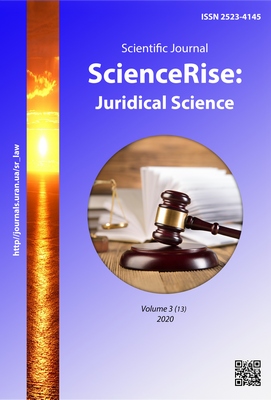International legal status and regime of the exclusive economic zone and the open sea: comparative characteristics
DOI:
https://doi.org/10.15587/2523-4153.2020.214010Keywords:
exclusive economic zone, high seas, principle of freedom of the high seas, delimitationAbstract
The scientific article "international legal status and regime of the exclusive economic zone and the high seas: comparative characteristics" is devoted to the study of the general understanding of the categories "exclusive economic zone", "high seas", as well as the definition of the international legal status and regime of the exclusive economic zone and the high seas, including for Ukraine as a maritime power, participating in activities for the use of the World Ocean. It is noted, that according to its legal status, the exclusive economic zone is an international territory and part of the high seas. Freedoms of the high seas are exercised within the exclusive economic zone, taking into account the peculiarities of its regime. Attention is focused on the fact that the international legal regime of the exclusive economic zone is determined by the special rights and obligations of the coastal state, as well as by certain rights of states that are landlocked or in a geographically disadvantaged position, which gives grounds to characterize the legal regime of the exclusive economic zone as a «sui generis». It is noticed, that the use of the territory of the high seas is determined by international law, that is, the high seas belongs to the international legal regime, is determined by the principle of freedom of the high seas and, by its status, is an international territory, not subject to national appropriation. It is emphasized, that the open sea includes a sea space with a specific legal regime (sui generis) - an exclusive economic zone, where the coastal state has separate rights and jurisdictions on the basis of international law. According to its status, the exclusive economic zone is part of the high seas, but the regime of the high seas in the exclusive economic zone is limited in terms of two freedoms - fishing and scientific research. In addition, the purpose of this scientific study, according to its results, is to highlight certain generalizations, definitions and conclusions, aimed at further processing the theoretical and practical problems of the indicated topic; in law-making activities; for teaching legal disciplines, writing textbooks, manuals, courses of lectures, teaching materials
References
- Rzhevska, V. S., Zabara, I. M. (2008). Mizhnarodne morske pravo. Kyiv: KNU, 189.
- Zabara, I. M.; Mytsyka, V. V. (Ed.) (2020). Mizhnarodne morske pravo. Mizhnarodne publichne pravo. Vol. 2. Osnovni haluzi. Kharkiv: Pravo, 374–404.
- Zadorozhnii, O. V., Rzhevska, V. S.; Huberskyi, L. V. et. al. (Eds.) (2013) Vidkrytoho moria svoboda. Ukrainska dyplomatychna entsyklopediia. Vol. 1. Kharkiv: Folio, 363–364.
- Tymchenko, L. D., Kononenko, V. P. (2012). Mizhnarodne pravo. Kyiv: Znannia, 631.
- Rzhevska, V. S.; Huberskyi, L. V. et. al. (Eds.) (2013). Vykliuchna ekonomichna zona. Ukrainska dyplomatychna entsyklopediia. Vol. 1. Kharkiv: Folio, 342–343.
- Rzhevska, V. S.; Huberskyi, L. V. et. al. (Eds.) (2013). Vidkryte more. Ukrainska dyplomatychna entsyklopediia. Vol. 1. Kharkiv: Folio, 361–362.
- Ustymenko, B., Ustymenko, T. (2020). Morski kordony yak kliuchovyi element ukrainskoho derzhavotvorennia: osnovni terminy ta vyznachennia. Available at: https://www.blackseanews.net/read/159953
- Ustymenko, B. (2020). Chornomorska bezpeka: 5 yurydychnykh krokiv Ukrainy. Available at: https://www.blackseanews.net/read/164609
- Yoshifumi, T. (2019). The International Law of the Sea. Cambridge: Cambridge University Press, 558. doi: http://doi.org/10.1017/9781108545907
- United Nations Convention on the Law of the Sea. Available at: https://www.un.org/depts/los/convention_agreements/texts/unclos/unclos_e.pdf
- United Nations Convention on the Law of the Sea (1994). United Nations. No. 31363. Available at: https://www.un.org/ru/documents/decl_conv/conventions/pdf/lawsea.pdf
- Konventsyia ob otkrytom more (1963). Available at: https://www.un.org/ru/documents/decl_conv/conventions/pdf/hsea.pdf
- Pro vykliuchnu (morsku) ekonomichnu zonu Ukrainy (1995). Zakon Ukrainy No. 162/95-VR. 16.05.1995. Available at: https://zakon.rada.gov.ua/laws/show/162/95-%D0%B2%D1%80#Text
- Kryminalnyi Kodeks Ukrainy (2001). Zakon Ukrainy No. 2341-III. 05.04.2001. Available at: https://zakon.rada.gov.ua/laws/show/2341-14#Text
- Hospodarskyi kodeks Ukrainy (2003). Zakon Ukrainy No. 436-IV. 16.01.2003. Available at: https://zakon.rada.gov.ua/laws/show/436-15#Text
Downloads
Published
How to Cite
Issue
Section
License
Copyright (c) 2020 Nataliia Kravchenko

This work is licensed under a Creative Commons Attribution 4.0 International License.
Our journal abides by the Creative Commons CC BY copyright rights and permissions for open access journals.
Authors, who are published in this journal, agree to the following conditions:
1. The authors reserve the right to authorship of the work and pass the first publication right of this work to the journal under the terms of a Creative Commons CC BY, which allows others to freely distribute the published research with the obligatory reference to the authors of the original work and the first publication of the work in this journal.
2. The authors have the right to conclude separate supplement agreements that relate to non-exclusive work distribution in the form in which it has been published by the journal (for example, to upload the work to the online storage of the journal or publish it as part of a monograph), provided that the reference to the first publication of the work in this journal is included.









